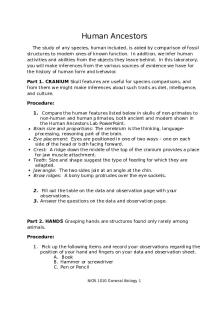Module 5 Lab 2 Chance in Genetic Variation Instructions and Worksheet PDF

| Title | Module 5 Lab 2 Chance in Genetic Variation Instructions and Worksheet |
|---|---|
| Author | Sarah K. |
| Course | General Biology |
| Institution | Metropolitan Community College, Nebraska |
| Pages | 7 |
| File Size | 150.9 KB |
| File Type | |
| Total Downloads | 42 |
| Total Views | 140 |
Summary
Download Module 5 Lab 2 Chance in Genetic Variation Instructions and Worksheet PDF
Description
BIOS 1010 General Biology Module 5 Lab 2
Name:
Chance in Genetic Variation Completing a Punnett square gives an expected result. If we have a large sample size (such as Mendel had with his peas), we can expect to get results close to these values. However, each fertilization is a random event that could have any of the four possible results. For example, we would predict that a family with 10 children would have 5 daughters and 5 sons. This might be the most common outcome; however, the family could have any combination of children from 0 daughters and 10 sons to 10 daughters and 0 sons. We will explore this variability in this lab. Additional help can be found in the Chance in Genetic Variation PowerPoint.
Part 1. Expectations versus Realities Making predictions is a part of the scientific problem-solving process. 1. As an example, consider the toss of a coin. If a coin is tossed 10 times, what head/tail count do you predict? Heads: 50% Tails: 50% What is your reason for this prediction? There are two sides to a coin, which means there is a half and half chance it will land on either side 100/2 = 50 2. Now toss a coin 10 times and record your results: Heads: 60% Tails: 40% If the results of the trial do not match your prediction, what are possible reasons? You can never be 100% certain that the results will be half heads and half tails, that’s just the highest probability since there are only two sides to the coin.
3. When experimental results match one’s expectations perfectly, there may be cause for rejoicing. Often there is not a perfect match, however, and doubts arise about the accuracy and adequacy of the data. Would you demand a perfect result of 5 heads and 5 tails to consider the trial to be a fair one? If not, how far off would you allow the result to be before you became suspicious of a trick? How did you decide that this is acceptable?
I don’t believe that would be fair, just because that’s the highest probability doesn’t mean its going to be the outcome ever single time. I think the results would be fairly close to being
even, but I don’t believe it would be exact. I think flipping a coin 100 times would be a good experiment to determine how accurate the probability would be.
Part 2. Variation in Families We are familiar with many examples of variation within a species and even within a family. A strong element of chance enters with each reproductive event – a chance that a certain ovum and a certain sperm, each having received a random mix of chromosomes during meiosis, will meet in fertilization. To simulate the se chance events, we will use playing cards.
Monohybrid Cross Let the two colors of cards represent alleles. 1. Shuffle the deck well, then split it into two equal piles. One pile represents sperm, the other ova.Let red cards represent dominant alleles ( R) and black cards represent recessive alleles (r). Since both piles contain red and black cares, you have represented parents with the Rr genotype. 2. Given what you know about inheritance write a hypothesis for what you think the result of 20 “fertilizations” (picking one card from each pile to create the genotype of each offspring) would be. What is your hypothesis for the result of 20 “fertilizations”, ie, how many RR, Rr and rr would you expect? (Hint: Use a Punnett square to get the predicted ratio and then use those ratios to come up with your numbers.) RR (red): 6 Rr (red): 10 rr (black): 4
3. Draw one card from each pile, representing, a sperm and an ovum. Together these represent one offspring. Record the genotype resulting from fertilization in the table 1 below. Results of 20 fertilizations Rr RR
rr
RR
Rr
rr
Rr
Rr
Rr
rr
Rr
rr
Rr
Rr
Rr
Rr
Rr
Rr
RR Rr
Complete the below to show how your results compare to your expectations. Genotype RR Rr rr
Tally 3 13 4
Total 3 13 4
Ratio 3:20 13:20 4:20
Expected 6 10 4
Phenotype Red
Ratio 16:20
Expected 16:20
Black
4:20
4:20
Do your results match your expectations satisfactorily? Why or Why not? The results were very close to my hypothesis. You can never be 100% accurate when predicting these things because there are so many possible outcomes.
Dihybrid Cross Let the four suits represent the alleles. 1. This time pile hearts and spades separately from diamonds and clubs, and shuffle both piles. Let hearts (H) = allele A, spades (S) = a, diamonds (D) = B, and clubs (C) = b . This represents both parents as AaBb. Presume complete dominance as suggested by letter size. Given what you know about inheritance what is your hypothesis for the numbers of each phenotype after 32 fertilizations. There will be four phenotypes: AB, Ab, aB, ab. (HINT: Use a Punnett square to come up with the ratio and then determine how many of each if you have 32 individuals.)
2. Draw one card from each pile to form a sperm, and then draw again one from each pile to form an ovum. Place these together representing a fertilization, record the genotype in the table below. Continue for at least 32 fertilizations, re-shuffling as needed, and complete the table. Results of 32 fertilizations
AaBb
aabb
Aabb
AabB
Aabb
AABb
AabB
aaBB
AAbB
AaBB
aaBb
AABB
AABb
AAbB
aABb
AAbB AAbb
AAbB
aaBB
aAbb
AABb
aaBb
AaBB
aabb
aaBb
AaBB
aabB
AAbb
AABb
AaBB
AaBB
aaBB
3. Complete the table below to show how your results compare to your expectations. Calculate the ratios as percent or decimals for easy comparison and compare with your prediction.
Hand
Genotype Total
HHDD
AABB
1
HSDD
AaBB
5
HHDC
AABb
4
HSDC
AaBb
1
HHCC
AAbb
2
HSCC
Aabb
2
SSDD
aaBB
3
SSDC
aaBb
4
SSCC
aabb
2
Phenotype
Total
Ratio
Expected Ratio
AB
11
34%
31%
Ab
4
12%
28%
21%
15%
6%
5%
aB
ab
7
2
4. Do your results match your expectations satisfactorily? Why or why not?
No because you can’t predict the exact outcomes regardless of probability, it just comes down to luck of the draw, quite literally....
Similar Free PDFs

5.4 - Genetic Variation
- 20 Pages

Unit 2- Variation in English
- 77 Pages

Module 5 Worksheet
- 6 Pages

Module 2 Worksheet
- 6 Pages

Worksheet Module 2
- 5 Pages

Genetic lab report
- 4 Pages
Popular Institutions
- Tinajero National High School - Annex
- Politeknik Caltex Riau
- Yokohama City University
- SGT University
- University of Al-Qadisiyah
- Divine Word College of Vigan
- Techniek College Rotterdam
- Universidade de Santiago
- Universiti Teknologi MARA Cawangan Johor Kampus Pasir Gudang
- Poltekkes Kemenkes Yogyakarta
- Baguio City National High School
- Colegio san marcos
- preparatoria uno
- Centro de Bachillerato Tecnológico Industrial y de Servicios No. 107
- Dalian Maritime University
- Quang Trung Secondary School
- Colegio Tecnológico en Informática
- Corporación Regional de Educación Superior
- Grupo CEDVA
- Dar Al Uloom University
- Centro de Estudios Preuniversitarios de la Universidad Nacional de Ingeniería
- 上智大学
- Aakash International School, Nuna Majara
- San Felipe Neri Catholic School
- Kang Chiao International School - New Taipei City
- Misamis Occidental National High School
- Institución Educativa Escuela Normal Juan Ladrilleros
- Kolehiyo ng Pantukan
- Batanes State College
- Instituto Continental
- Sekolah Menengah Kejuruan Kesehatan Kaltara (Tarakan)
- Colegio de La Inmaculada Concepcion - Cebu









